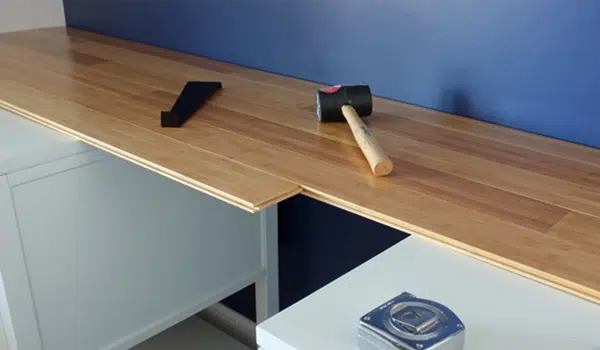In recent years, bamboo countertops have gained popularity in homes as a sustainable alternative to traditional materials. Resembling the appeal of wooden countertops, bamboo countertops are renowned for their strength, durability, and warm aesthetic.
Not only do bamboo countertops exude a similar charm to traditional woodwork, but they also stand out for their enhanced durability. They provide a cost-effective option, delivering exquisite beauty comparable to marble and granite at a fraction of the cost.
Beyond their visual appeal and affordability, bamboo countertops contribute to eco-friendly kitchen designs. As a rapidly renewable resource, bamboo aligns with sustainable practices, making it a conscientious choice for homeowners seeking both style and environmental responsibility.
Bamboo Countertop Varieties
Bamboo countertops offer four main types, each featuring distinct surface appearances: vertical grain, end grain, flat grain, and strand woven.
1. Vertical Grain:
- Description: This is the most popular type where bamboo strips are joined vertically, creating a striped pattern and recognizable lines.
- Characteristics: Easily identifiable due to its striped pattern and vertical orientation.
2. End Grain:
- Description: Resembling parquet butcher block, end grain bamboo countertops are crafted by adhering small bamboo chunks in specific designs.
- Characteristics: Known for tight grain and exceptional scratch resistance.
3. Flat Grain:
- Description: Also known as face grain countertops, bamboo is split open, and the pieces are joined face-up.
- Characteristics: Features a distinct grain pattern and appearance.
4. Strand Woven:
- Description: Created by weaving strands together, applying intense pressure, and lacking angular characteristics of solid wood.
- Characteristics: Resembles solid wood more than other bamboo countertop types.
Constructing Bamboo Countertops

Bamboo countertops require adhesives and pressure during construction since no single bamboo piece is large enough for a fully solid surface. There are two main construction methods:
1. Solid Bamboo Countertops:
- Description: Manufactured by bonding solid bamboo pieces together in different patterns.
- Characteristics: Available in various internal structures and thicknesses.
2. Plywood Bamboo Countertops:
- Description: Fabricators create these by forcefully bonding bamboo sheets together and can reveal various grain patterns by tearing apart boards or panels.
- Characteristics: Offers flexibility in grain patterns.
Bamboo Countertop Pricing
- Material Cost: Ranges from $25 to $100 per square foot.
- Average Cost: Expect to pay $2,000 to $3,000 for a 50-square-foot portion.
- Labor Cost: Typically ranges from $5 to $15 per square foot.
Factors Influencing Price:
- Bamboo Type: Countertops made from Moso bamboo, known for toughness, are pricier.
- Adhesives: Healthier adhesives without formaldehyde may increase costs.
- Environmentally Friendly Options: Choosing eco-friendly options can affect pricing.
Cost-Saving Tips:
- Comparison: Compare prices among manufacturers.
- Promotions: Watch for promotions and discounts.
- Builder’s Grade: Opt for a less expensive type and finish known as builder’s grade.
- DIY Installation: Save on labor costs by installing bamboo countertops yourself.
Daily Maintenance of Bamboo Countertops

Maintaining the quality of your bamboo countertops through routine care is essential for their longevity. Follow these easy steps:
- Clean Up Spills Immediately: Bamboo, like wood, can stain when exposed to standing water. Wipe away liquid spills promptly to prevent any potential damage.
- Avoid Abrasive Products: Use a soft cloth, sponge, warm water, or mild soap for cleaning. Steer clear of abrasive pads or cleansers as they may scratch the surface.
- Use Cutting Boards: Protect your bamboo counters from dents and scratches by using cutting boards when chopping food.
- Use Trivets and Hot Pads: Bamboo countertops are heat-sensitive, so use trivets and hot pads to shield them from hot surfaces and prevent burns.
Maintenance Requirements for Bamboo Countertops
Keep your bamboo countertops looking beautiful with ongoing maintenance:
- Avoid Damage: Be proactive in preventing harm. Use cutting boards while preparing food, and avoid leaving liquids on the countertop. Refrain from using scouring pads or harsh cleansers to maintain the surface polish. Also, use trivets or hot pads for hot pots and pans to prevent burn marks.
- Regularly Oil the Surface: Apply a coat of food-safe oil, such as mineral, linseed, or tung oil, every few months to prevent the surface from becoming dry and brittle. Apply the oil with a gentle cloth and wipe off any excess.
- Consider a Sealer: Choose a sealer based on personal preferences and family allergies. Options include mineral, tung, or linseed oil for a natural look or varnish and polyurethane for a longer-lasting finish.
- Sand Out Scratches: For scratches and dents, use fine-grit sandpaper (between 120 and 180). Sand slowly in the direction of the grain until the mark is gone, achieving a smooth surface. For an even smoother finish, use a higher grit during finishing.
- Address Damage Promptly: Promptly address any countertop issues to prevent worsening problems in the future.





Leave a Reply